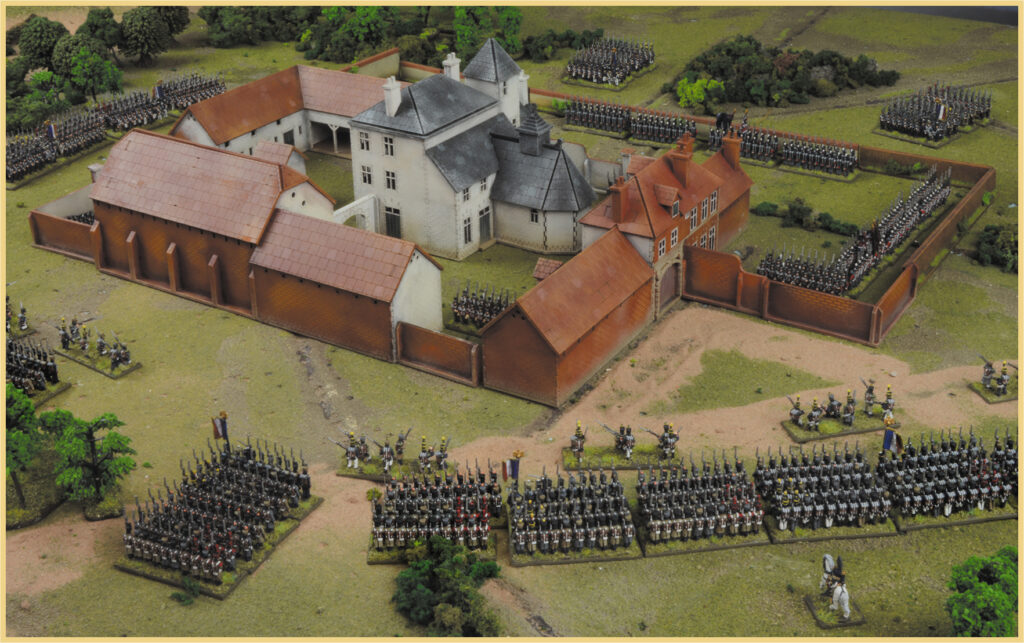As we enter what we in the Warlord Games Design Studio have taken to calling ‘Waterloo Season’, we’re continuing to look at the physical landscape of the battle, and the structures that helped shape the course of history on that legendary day in June. This time, we’re heading to the village of Plancenoit, where the delayed Prussian forces entered the fray and turned the tide of the battle against Napoleon. Those excellent types over at Sarissa Precision have produced a properly awesome MDF kit of the village church and graveyard, scene of some of the most brutal close-quarters fighting of the day, and the perfect addition to any Epic Battles: Waterloo tabletop.

Today, Plancenoit is a sleepy Belgian village of less than 2,000 people, but on the evening of the 18th of June 1815 it was a burning ruin, choked with corpses. Amidst the narrow streets and through the houses, Prussian infantry clashed with the legendary French Imperial Guard in a battle more reminiscent of the last days of World War Two than the early Nineteenth Century.
At about 4pm, while Ney’s cavalry was massing for its great assault on Wellington’s position, Prussian General von Bülow’s IV Korps (4th Corps) advanced out of the Bois de Paris forest and moved to secure Plancenoit. Advance elements of von Bülow’s force were able to take the village after fierce fighting, driving the French defenders out in a taste of the bloody close-in work to come. Knowing that he could not afford to lose the village and give the enemy a beachhead behind his lines, Napoleon ordered the elite light infantry of the Young Guard under General Duhesme to retake the village. While the Prussians resisted, the French fixed their bayonets and swiftly drove them out of the village, pursuing them into the open ground beyond. The fighting was intense, and Duhesme was carried away having suffered a head wound – he would die two days later.
Despite the best efforts of the Young Guard, more Prussian reinforcements were arriving with every passing moment, and a counterattack of two columns drove the French out of the western side of the village and forced them to take shelter in the church and graveyard. Hopelessly outnumbered, the Young Guard were forced back, inch-by-inch, until a retreat was finally ordered. The French, however, would not allow Plancenoit to fall so easily. Two battalions of the legendary Old Guard charged into the melee with bayonets fixed under the command of General Pelet. Cutting their way into the village, they were able to regain control of the church, sheltering behind the graveyard’s walls.
As the evening progressed and the situation deteriorated, more and more Prussian forces were fed into the hellish engagement in Plancenoit. The carnage was renowned as some of the worst on the entire battlefield – certainly no mean feat! By the end of the battle, as the last battered French survivors either fell or surrendered, the streets were recorded as being awash with blood, and confusion reigned among the burning buildings. The cost had been great (with around 6,000 casualties sustained by each side), but the French had held on to Plancenoit long enough to prevent the Prussians from completely breaking into their rear areas – although this was not enough to win them the battle.
The iconic centrepiece of Plancenoit was the church which (much repaired) still stands to this day. Surrounded by a wall, it formed the linchpin of the French defence, and saw scenes of incredibly fierce fighting throughout the afternoon and evening. With the Sarissa MDF kit, you can add this vitally important building to your Epic Battles: Waterloo tabletop – it can make the perfect main feature on a Plancenoit-themed table, or complete the Waterloo experience with Hougoumont, La Haye Sainte & Papelotte for a truly epic board.
Fix bayonets, and march into Plancenoit – will you hold the church for Napoleon, or seize it for Blücher?
The Wider Battlefield
Explore other iconic sections of the field of Waterloo with these other scenery sets; the settings for some of the most studied military actions in history:













